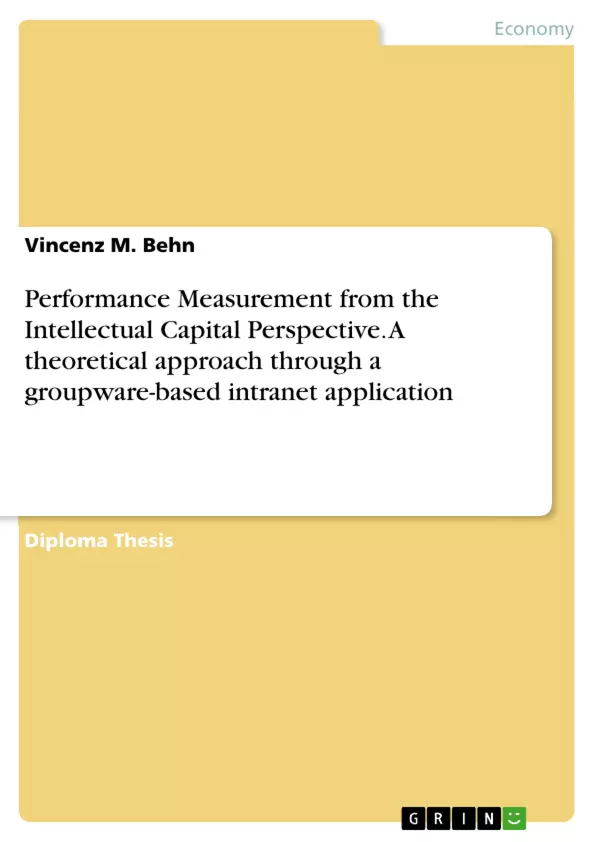Introduction
The transformation from the industrial age to the information age(1) or knowledge society(2) represents a time of great change for business organizations as well as for individuals. Service industries replace manufacturing industries and the traditional
factors of production: land, labor, and capital are replaced by intellectual assets as the scarce resources. “If there is one distinguishing feature of the new economy that has developed as a result of powerful forces such as global competition, it is the
ascendancy of intellectual capital.”(3) Intellectual capital (IC) and its measurement is the main topic of this research project. The declining importance of physical assets as well as the quest for shareholder value creation have made the performance evaluation of companies that used to be solely based on financial figures inadequate.
For information age companies it is essential to value performance beyond quantitative measures.(4) Practitioners like Security Exchange Commissioner (SEC) Steven Wallmann as well as academics like New York University’s Stern School of Business accounting professor Baruch Lev stress the current accounting model’s bias
towards physical assets and emphasize the necessity of incorporating non-financial measures to evaluate organizational performance.(5) The Balanced Scorecard (BSC) is a performance management and measurement system that fulfills this criterion. In addition to the traditional Financial Perspective, the BSC measures performance
from the Customer Perspective, the Internal Business Process Perspective, and the Learning and Growth Perspective, thereby functioning as a tool to navigate businesses in a competitive environment that is growing more and more complex.
The aim of the thesis is to illustrate how the BSC can be used as a strategic management system that places a strong focus on IC and its measurement.
Furthermore, it will be analyzed how information technology (IT) can be used to facilitate a BSC and its implementation.
[...]
______
1 Stewart (1997): p. 3
2 Drucker (1996): p. 67
3 Bontis (1998): p. 64
4 Eccles (1991): p. 131
5 Lev (1997): p. 1; Wallman (1997): p. 104
Inhaltsverzeichnis (Table of Contents)
- 1 Introduction
- 2 Strategic Management in the Information Age
- 2.1.1 The Industry-Based View of the Firm
- 2.1.2 The Resource-Based View of the Firm
- 2.2 A New Type of Organization
- 2.2.1 Characteristics of the New Organization
- 2.2.2 New Organizational Forms
- 2.2.3 New Strategies
- 2.3 Value Creation in the Information Age
- 3 Intellectual Capital
- 3.1 Shortcomings of Traditional Accounting Methods
- 3.2 Economics of Knowledge-Based Resources
- 3.3 The Concept of Intellectual Capital
- 3.3.1 Human Capital
- 3.3.2 Structural Capital
- 3.3.3 Customer Capital
- 4 Performance Measurement with the Balanced Scorecard
- 4.1 Financial Perspective
- 4.2 Customer Perspective
- 4.3 Internal Business Process Perspective
- 4.4 Learning and Growth Perspective
- 4.5 The BSC as a Strategic Management System
- 4.5.1 Cause-and-Effect Relationship
- 4.5.2 Implementing a Balanced Scorecard
- 4.5.2.1 Clarifying and Translating Vision and Strategy
- 4.5.2.2 Communicating and Linking
- 4.5.2.3 Planning and Target Setting
- 4.5.2.4 Strategic Feedback and Learning
- 4.6 A Critical Look at the Balanced Scorecard
- 5 Enabling the Balanced Scorecard
- 5.1 Requirements for an Automated Balanced Scorecard
- 5.1.1 Strategic Requirements
- 5.1.2 Technical Requirements
- 5.1.3 A Critical Look at Automated Balanced Scorecard Solutions
- 5.2 NetFicient
- 5.2.1 NetFicient Add-Ons
- 5.2.2 NetFicient Knowledge
- 5.2.3 eSurvey and NetFicient Project
- 5.2.4 A Critical Look at NetFicient to Support a Balanced Scorecard
- 5.3 Conclusion
- 5.1 Requirements for an Automated Balanced Scorecard
- 6 Outlook
Zielsetzung und Themenschwerpunkte (Objectives and Key Themes)
This diploma thesis aims to provide a theoretical approach to support a corporate performance measurement system through a groupware-based intranet application. The focus is on integrating the intellectual capital perspective into the Balanced Scorecard (BSC) framework, considering the implications of the information age for strategic management and value creation.
- The evolution of strategic management in the information age
- The limitations of traditional accounting methods in capturing intangible assets
- The concept of intellectual capital and its three main components (human capital, structural capital, and customer capital)
- The Balanced Scorecard framework and its four perspectives (financial, customer, internal processes, and learning & growth)
- The potential and challenges of using groupware-based intranet applications to enable the implementation of the Balanced Scorecard
Zusammenfassung der Kapitel (Chapter Summaries)
Chapter 1 introduces the topic and outlines the structure of the thesis. Chapter 2 examines the shift in strategic management paradigms driven by the information age, focusing on the industry-based and resource-based views of the firm. It explores the characteristics, forms, and strategies of new organizations in this context. Chapter 3 delves into the concept of intellectual capital, highlighting the shortcomings of traditional accounting methods in measuring intangible assets. The chapter then analyzes the economics of knowledge-based resources and explores the different components of intellectual capital: human capital, structural capital, and customer capital. Chapter 4 presents the Balanced Scorecard (BSC) as a performance measurement system, explaining its four perspectives and how it can be used as a strategic management tool. It also discusses the importance of cause-and-effect relationships and the steps involved in implementing a BSC effectively. Chapter 5 explores the potential and challenges of enabling the Balanced Scorecard through automated solutions, specifically examining the requirements for such systems. The chapter then focuses on NetFicient, a groupware-based intranet application, analyzing its features and capabilities in supporting the BSC framework.
Schlüsselwörter (Keywords)
This diploma thesis focuses on intellectual capital, performance measurement, Balanced Scorecard, strategic management, information age, groupware, intranet applications, and value creation.
- Quote paper
- Vincenz M. Behn (Author), 2000, Performance Measurement from the Intellectual Capital Perspective. A theoretical approach through a groupware-based intranet application, Munich, GRIN Verlag, https://www.grin.com/document/294



